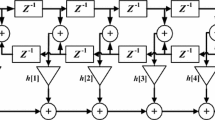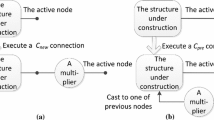Abstract
Evolutionary computational techniques have been employed judiciously in various signal processing applications of late. In this paper, such an attempt has been made to design a low-pass linear-phase multiplier-less finite duration impulse response (FIR) filter using differential evolution (DE) algorithm. This particular evolutionary optimization technique has been explored to search the impulse response coefficients of the FIR filter in the form of sum of power of two (SPT) in order to avoid the multipliers during design process. The performance of the designed low-pass filter has been studied thoroughly in terms of its frequency characteristics and primitive requirement of fundamental hardware blocks. The superiority of our design has been ascertained over a number of existing techniques by various means. Finally, the proposed filter of different lengths has been implemented on a field programmable gate array (FPGA) chip for evaluating the competency of this work. The percentage improvement in hardware complexity produced by our design has also been computed and clearly listed in this paper for convenience.
Similar content being viewed by others
Abbreviations
- CR::
-
Recombination or cross-over probability
- D::
-
Dimension of parameter vector in DE
- \({D_N^N}:\) :
-
N × N Square matrix of twiddle factors
- e::
-
Input signal to FIR filter
- E::
-
Input signal matrix
- F,F 1 ,F 2::
-
Weighting factor(s)
- \({\Im, \psi}:\) :
-
Cost function associated with DE
- G::
-
Generation number in DE
- h k ::
-
kth tap coefficient of FIR filter
- H::
-
Impulse response vector of FIR filter
- \({\mathcal{H}}:\) :
-
Frequency sample vector of FIR filter
- L::
-
Length of the impulse response of FIR filter
- M::
-
Total number of output samples from FIR filter under consideration
- \({\mathbb{M}}:\) :
-
Binary mask set
- \({\mathfrak{M}}:\) :
-
Symbolic mutation operation
- N::
-
Total number of frequency samples
- \({\mathbb{N}}\) :
-
Number of elements in a set
- P::
-
Size of population in DE
- \({\Re}:\) :
-
Symbolic recombination or cross-over operation
- \({\mathbb{R}}:\) :
-
Set of real numbers
- s::
-
Element of binary mask
- \({\mathbb{S}}:\) :
-
Summation of all the elements from a set
- \({\mathfrak{S}}:\) :
-
Symbolic selection operation
- U::
-
Trial vector in DE
- V::
-
Donor vector in DE
- W::
-
Twiddle factor
- ω p ::
-
Pass-band edge frequency
- ω s ::
-
Stop-band edge frequency
- X::
-
Parameter vector in DE
- y::
-
Output signal from FIR filter
- Y::
-
Output signal vector
- \({\Upsilon}:\) :
-
Parameter/trial vector in DE
- \({\lambda}:\) :
-
Control parameter of DE
- Θ::
-
Set of the population members
- \({\zeta}:\) :
-
Value of fitness function
- Δ::
-
Word length of FIR filter coefficients
- \({\emptyset}:\) :
-
Mathematical function
- δ p ::
-
Maximum pass-band ripple in dB
- δ s ::
-
Minimum stop-band attenuation in dB
References
Proakis J.G.: Digital Signal Processing: Principles, Algorithms, and Applications. Prentice Hall, India (1997)
Mitra S.K.: Digital Signal Processing: A Computer-based Approach, 2nd edn. McGraw Hill, New York (2001)
Antoniou A.: Digital Filters: Analysis, Design and Applications. McGraw-Hill, NewYork (2001)
Somanathan Nair B.: Digital Signal Processing: Theory, Analysis and Digital-Filter Design. Prentice-Hall, India (2004)
Samueli H.: An improved search algorithm for the design of multiplier-less FIR filters with power-of-two coefficients. In: IEEE Trans. Circuits Syst. 36, 1044–1047 (1989)
Li, D., Song, J., Lim, Y.C.: A polynomial-time algorithm for designing digital filters with power-of-two coefficients. In: Proceedings of the IEEE International Symposium on Circuits and Systems, vol. 1, pp. 84–87 (1993)
Lim Y.C.: Design of discrete-coefficient-value linear phase FIR filters with optimum normalized peak ripple magnitude. In: IEEE Trans. Circuits Syst. 37, 1480–1486 (1990)
Benvenuto N., Marchesi M., Uncini A.: Applications of simulated annealing for the design of special digital filters. In: IEEE Trans. Signal Process. 40, 323–332 (1992)
Chen C., Willson A.N.: A trellis search algorithm for the design of FIR filters with signed-powers-of-two coefficients. In: IEEE Trans. Circuits Syst.-II: Analog. Digit. Signal Process. 46(1), 29–39 (1999)
Lim Y.C., Parker S.R.: FIR filter design over a discrete powers-of-two coefficient space. In: IEEE Trans. Acoust. Speech. Signal Process. ASSP 31, 583–591 (1983)
Kaakinen, J.Y., Saramaki, T.: A systematic algorithm for the design of multiplierless FIR filters. In: Proceedings of the 2001 IEEE International Symposium on Circuits and Systems, vol. 2, pp. 185–188 (2001)
Jheng, K., Jou, S., Wu, A.: A design flow for multiplierless linear-phase FIR filters: from system specification to verilog code. In: Proc 2004 IEEE International Symposium on Circuits and Systems, vol 5, pp. 293–296 (2004)
Xu F., Chang C.H., Jong C.C.: Design of low-complexity FIR filters based on signed-powers-of-two coefficients with reusable common subexpressions. In: IEEE Trans. Comput. Aided Des. Integr. Circuits Syst. 26(10), 1898–1907 (2007)
Feng Z.G., Teo K.L.: A discrete filled function method for the design of FIR filters with signed-powers-of-two coefficients. In: IEEE Trans Signal Process. 56(1), 134–139 (2008)
Wang Y., Roy K.: CSDC: a new complexity reduction technique for multiplierless implementation of digital FIR filters. In: IEEE Trans. Circuits Syst.-I Regul. Pap. 52(9), 1845–1853 (2005)
Pan, S.T., Tsai, B.Y., Yang, C.S.: Differential evolution algorithm on Robust IIR filter design and implementation. In: Proceedings of the eighth international conference on intelligent systems design and application, pp. 537–542, (2008)
Storn R., Price K.: Differential evolution—a simple and efficient heuristic for global optimization over continuous spaces. J. Glob. Optim. 11(4), 41–359 (1997)
Storn, R., Price, K.: Differential Evolution—a Simple and Efficient Adaptive Scheme for Global Optimization Over Continuous Spaces. International Computer Science Institute, Berkeley, TR-095-012 (1995)
Storn R., Price K.: Differential evolution: a simple evolution strategy for fast optimization. Dr. Dobb’s J. Softw. Tools 22(4), 18–24 (1997)
Storn R., Price K., Lampinen J.: Differential Evolution: A Practical Approach to Global Optimization. Springer, Berlin (2005)
Das S., Abraham A., Konar A.: Particle swarm optimization and differential evolution algorithms: technical analysis, applications and hybridization perspectives. Stud. Comput. Intell. (SCI) 116, 1–38 (2008)
Das S., Suganthan P.N.: Differential evolution: a survey of the state-of-the-art. In: IEEE Trans. Evolut. Comput. 15(1), 4–31 (2011)
Storn R.: Designing nonstandard filters with differential evolution. In: IEEE Signal Process. Mag. 22(1), 103–106 (2005)
Storn, R.: Differential evolution design of an IIR filter. In: Proceedings of the IEEE International Conference on Evolutionary Computation, pp. 268–273 (1996)
Karaboga N.: Digital filter design using differential evolution algorithm. EURASIP J. Appl. Signal Process. 8, 1269–1276 (2005)
Luitel, B., Engelbrecht, A.P.: Differential evolution particle swarm optimization for digital filter design. In: Proceedings of the IEEE World Congress on Computational Intelligence, pp. 3954–3961 (2008)
Qing A.: Electromagnetic inverse scattering of multiple two-dimensional perfectly conducting objects by the differential evolution strategy. In: IEEE Trans. Antennas Propag. 51(6), 1251–1262 (2003)
Michalski K.A.: Electromagnetic imaging of elliptical-cylindrical conductors and tunnels using a differential evolution algorithm. Microw. Opt. Technol. Lett. 28(3), 164–169 (2001)
Yang S., Gan Y.B., Qing A.: Sideband suppression in time-modulated linear arrays by the differential evolution algorithms. In: IEEE Antennas Wirel. Propag. Lett. 1(1), 173–175 (2002)
Qing A., Xu X., Gan Y.B.: Anisotropy of composite materials with inclusion with orientation preference. In: IEEE Trans. Antennas Propag. 53(2), 737–744 (2005)
Chattopadhyay, S., Sanyal, S.K., Chandra, A.: Design of FIR pulse-shaping filter: superiority of differential evolution optimization over convex optimization. In: Proceedings of the 5th European Conference on Circuits and Systems for Communication, Belgrade, Serbia, pp. 189–192, Nov. 23–25 (2010)
Author information
Authors and Affiliations
Corresponding author
Rights and permissions
About this article
Cite this article
Chandra, A., Chattopadhyay, S. A novel approach for coefficient quantization of low-pass finite impulse response filter using differential evolution algorithm. SIViP 8, 1307–1321 (2014). https://doi.org/10.1007/s11760-012-0359-4
Received:
Revised:
Accepted:
Published:
Issue Date:
DOI: https://doi.org/10.1007/s11760-012-0359-4




